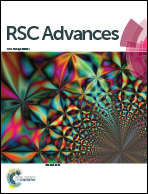Preparation of polyimide films via microwave-assisted thermal imidization
Abstract
A series of polyimide (PI) films based on aromatic heterocyclic monomers of 3,3′,4,4′-biphenyltetracarboxylic dianhydride (BPDA), p-phenylenediamine (p-PDA) and 4,4′-oxydianiline (ODA) were prepared via a microwave-assisted thermal imidization and conventional thermal imidization method at different temperatures. The effects of microwave irradiation on the imidization degree, microstructures, mechanical and thermal properties of PI films were investigated. The imidization degree of the PI films treated with microwave-assisted heating reached a relatively high value at 250 °C, which was twice as much as those treated with traditional thermal imidization. The tensile strength and modulus of PI films treated with microwave-assisted imidization at 300 °C were 187.61 MPa and 2.71 GPa respectively, which were 30% higher than those of PI films treated with thermal imidization. Moreover, the order degree of polymer chains was improved by the microwave-assisted imidization method. The PI films prepared by the microwave-assisted imidization method showed excellent thermal stability with a 5% weight loss temperature of 573 °C under N2. The microwave-assisted thermal imidization proved to be a rapid and efficient way to prepare high-performance polyimide materials.



 Please wait while we load your content...
Please wait while we load your content...